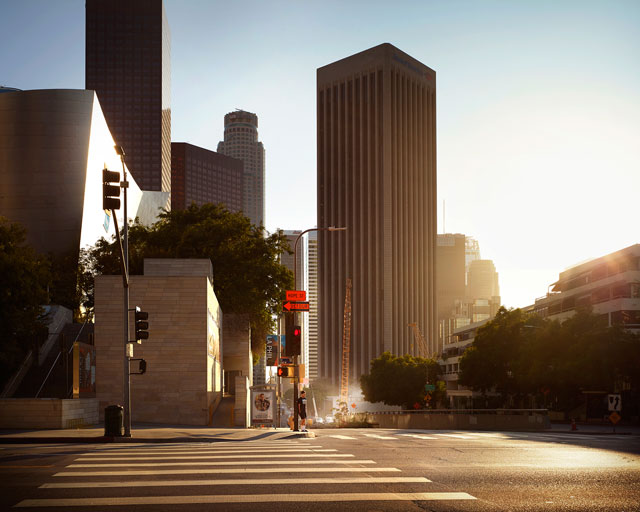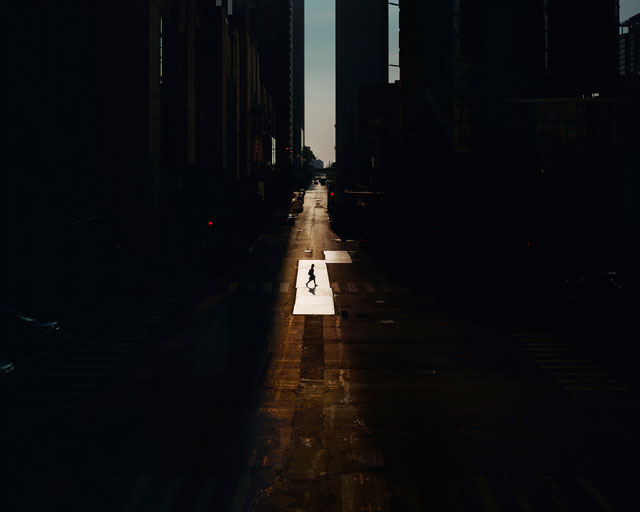
Oli Kellett. Cross Road Blues (6th St, LA), 2016. © Oli Kellett / Courtesy HackelBury Fine Art.
HackelBury Fine Art, London
16 November 2018 – 23 February 2019
by IMOGEN GREENHALGH
The woman hasn’t noticed the camera. Elevated high above her, as she waits at the road junction for the crossing light to turn green, it exists like countless other lenses suspended over our heads. Fastened to lampposts or couched beneath the rafters, all-seeing but mostly unseen, these cameras work together to capture and log our movements, silently taking note. But this camera is different, more benign, less exacting. Operated by the British photographer Oli Kellett (b1983), it does not care where the woman is headed, nor where she comes from. It catches her from afar, careful not to invade, preserving her anonymity. She is sealed in private reverie as she waits to cross the road. When the light changes, the city will reabsorb her, withdrawing her from view.

Oli Kellett. Cross Road Blues (Alaskan Way Seattle), 2017. Archival pigment print, 101.6 x 127 cm (40 x 50 in). © Oli Kellett / Courtesy HackelBury Fine Art.
“It’s an expression, I guess,” explains Kellett, when I ask what it is he looks for as he waits for his subjects, his large-format architectural camera trained on the streets below. “It could be a certain posture, the way someone might look up, for instance, and give you this sense that they are experiencing something greater than themselves, spiritual almost.” The images that result from Kellett’s studies make up an ongoing series, Cross Road Blues, 12 images from which –including Cross Road Blues (Figueroa St, LA), 2016, described above – are now on display at HackelBury Fine Art, in this, his first solo show. Together, they revise our image of the city, recasting it as a place of stillness and solitude.

Oli Kellett. Cross Road Blues (Figueroa St, LA), 2016. Archival pigment print, 101.6 x 127 cm (40 x 50 in). © Oli Kellett / Courtesy HackelBury Fine Art.
Figures in Kellett’s series are mostly alone, and usually appear as if locked in some kind of trance or fugue state. His practice resists the on-the-fly tradition more visible within the canon of street photography. “I feel uneasy pursuing someone with a handheld camera,” he says over the phone from his home in Hastings, East Sussex. “I’d prefer the people to come to me. Morally, I’m much happier with that.” Instead, Kellett traverses the streets of US cities, assessing light and vantage points before settling on a spot, unpacking his large and unwieldy camera, and setting up a makeshift studio. After that, he simply watches and waits.

Oli Kellett. Cross Road Blues (Hope St, LA), 2017. Archival pigment print, 81.3 x 101.6 cm (32 x 40 in). © Oli Kellett / Courtesy HackelBury Fine Art.
This means the final images in Cross Road Blues exist as something more than chance, but less than staged. From a day camped out, Kellett might produce only one image he is satisfied with, or sometimes none. In some cities he visits, no image makes the final cut: “I did try shooting in New York, but it wasn’t right. It’s somehow too well-known, too famous, I guess. The point is with these images is that, though I’ve travelled to lots of cities, they could almost be anywhere.” Anonymous and individual, like the people meandering their streets.

Oli Kellett. Cross Road Blues (Illinois St Chicago), 2016. Archival pigment print, 101.6 x 127 cm (40 x 50 in). © Oli Kellett / Courtesy HackelBury Fine Art.
The roots of the series lie in the 2016 presidential election, a period Kellett spent in the US. Inspired in part by Election Eve, William Eggleston’s acclaimed 1977 photobook, Kellett, armed with his camera, set out to capture the palpable sense of confusion. He began to shoot crossroads simply as a kind of shorthand for the febrile mood, with the immense scale of the country’s traffic intersections helping to convey the enormity of the decision faced by inhabitants, as well as their powerlessness, dwarfed by a system far greater than them.

Oli Kellett. Cross Road Blues (Stockton St, San Francisco), 2017. Archival pigment print, 81.3 x 101.6 cm (32 x 40 in). © Oli Kellett / Courtesy HackelBury Fine Art.
But as the series progressed, these junctions came to act as more than just a metaphor for the contemporary political malaise: “Crossroads are democratic places, in that we’ve all got to stop and wait, particularly in America, where you can’t just cross between cars. And they’ve also got this weirdly interesting history, appearing in lots of legends and things. We used to bury criminals at crossroads, in the hope that they would lose their way home if they returned from the dead.”

Oli Kellett. Cross Road Blues (William St, Atlanta), 2017. Archival pigment print, 81.3 x 101.6 cm (32 x 40 in). © Oli Kellett / Courtesy HackelBury Fine Art.
One tale Kellett kept returning to was that of the celebrated blues musician Robert Johnson, who, so the story goes, went to meet a stranger at a Mississippi crossroads. “It turned out to be the devil, who would give him a perfect singing voice and mastery of the guitar in return for his soul.” According to the tale, Johnson accepted the deal, securing both fame and fortune and a life blighted by tragedy.

Oli Kellett. Cross Road Blues (Van Buren Way, Phoenix), 2017. Archival pigment print, 152.4 x 190.5 cm (60 x 75 in). © Oli Kellett / Courtesy HackelBury Fine Art.
Kellett’s own studies have a less obvious relation to plot, although each holds a kernel of potential, hinting at possible narratives that might emerge. Printed large-scale, each a metre or so in width, details are revealed up close. A middle-aged man stands dazed beneath an American Cancer Society sign, while a little further down, another sign reads “One Way”. A woman in a Batman T-shirt waits on the pavement in the amber, early morning light, a modern-day superhero at the end of her shift. A family (one of the few groups within the series) stands, each member gazing in a different direction, their attention dispersed by life beyond their enclosed unit. These are not sophisticated storylines by any means, nor is their message fixed. Instead, they reflect the photographer’s attentiveness to the flow of life in the city, the way meaning ebbs and flows between the changing lights.